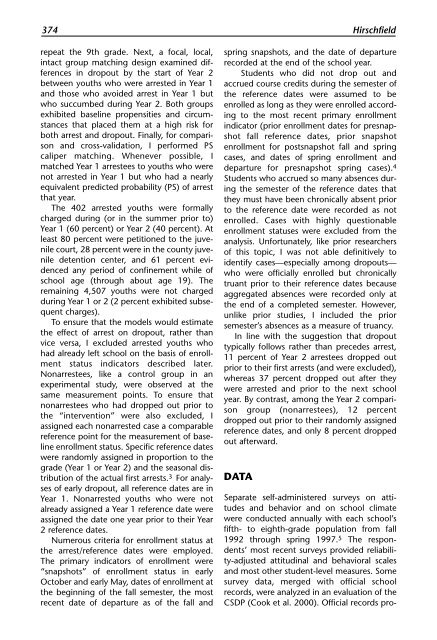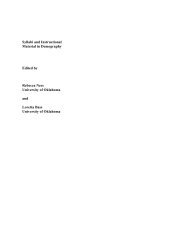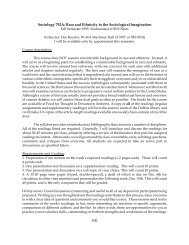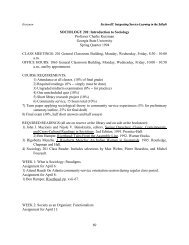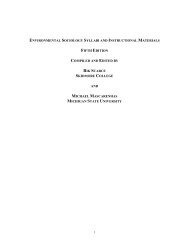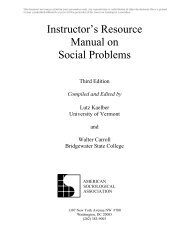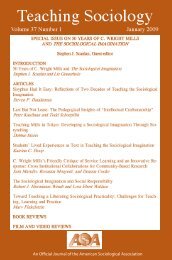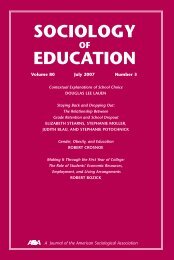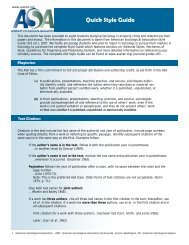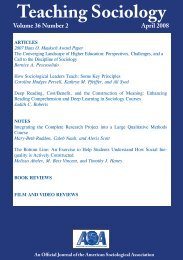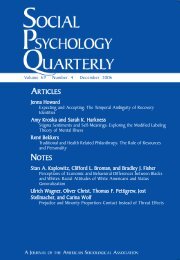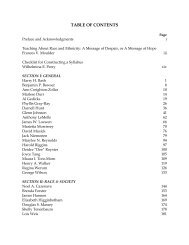SOCIOLOGY EDUCATION - American Sociological Association
SOCIOLOGY EDUCATION - American Sociological Association
SOCIOLOGY EDUCATION - American Sociological Association
Create successful ePaper yourself
Turn your PDF publications into a flip-book with our unique Google optimized e-Paper software.
374 Hirschfield<br />
repeat the 9th grade. Next, a focal, local,<br />
intact group matching design examined differences<br />
in dropout by the start of Year 2<br />
between youths who were arrested in Year 1<br />
and those who avoided arrest in Year 1 but<br />
who succumbed during Year 2. Both groups<br />
exhibited baseline propensities and circumstances<br />
that placed them at a high risk for<br />
both arrest and dropout. Finally, for comparison<br />
and cross-validation, I performed PS<br />
caliper matching. Whenever possible, I<br />
matched Year 1 arrestees to youths who were<br />
not arrested in Year 1 but who had a nearly<br />
equivalent predicted probability (PS) of arrest<br />
that year.<br />
The 402 arrested youths were formally<br />
charged during (or in the summer prior to)<br />
Year 1 (60 percent) or Year 2 (40 percent). At<br />
least 80 percent were petitioned to the juvenile<br />
court, 28 percent were in the county juvenile<br />
detention center, and 61 percent evidenced<br />
any period of confinement while of<br />
school age (through about age 19). The<br />
remaining 4,507 youths were not charged<br />
during Year 1 or 2 (2 percent exhibited subsequent<br />
charges).<br />
To ensure that the models would estimate<br />
the effect of arrest on dropout, rather than<br />
vice versa, I excluded arrested youths who<br />
had already left school on the basis of enrollment<br />
status indicators described later.<br />
Nonarrestees, like a control group in an<br />
experimental study, were observed at the<br />
same measurement points. To ensure that<br />
nonarrestees who had dropped out prior to<br />
the “intervention” were also excluded, I<br />
assigned each nonarrested case a comparable<br />
reference point for the measurement of baseline<br />
enrollment status. Specific reference dates<br />
were randomly assigned in proportion to the<br />
grade (Year 1 or Year 2) and the seasonal distribution<br />
of the actual first arrests. 3 For analyses<br />
of early dropout, all reference dates are in<br />
Year 1. Nonarrested youths who were not<br />
already assigned a Year 1 reference date were<br />
assigned the date one year prior to their Year<br />
2 reference dates.<br />
Numerous criteria for enrollment status at<br />
the arrest/reference dates were employed.<br />
The primary indicators of enrollment were<br />
“snapshots” of enrollment status in early<br />
October and early May, dates of enrollment at<br />
the beginning of the fall semester, the most<br />
recent date of departure as of the fall and<br />
spring snapshots, and the date of departure<br />
recorded at the end of the school year.<br />
Students who did not drop out and<br />
accrued course credits during the semester of<br />
the reference dates were assumed to be<br />
enrolled as long as they were enrolled according<br />
to the most recent primary enrollment<br />
indicator (prior enrollment dates for presnapshot<br />
fall reference dates, prior snapshot<br />
enrollment for postsnapshot fall and spring<br />
cases, and dates of spring enrollment and<br />
departure for presnapshot spring cases). 4<br />
Students who accrued so many absences during<br />
the semester of the reference dates that<br />
they must have been chronically absent prior<br />
to the reference date were recorded as not<br />
enrolled. Cases with highly questionable<br />
enrollment statuses were excluded from the<br />
analysis. Unfortunately, like prior researchers<br />
of this topic, I was not able definitively to<br />
identify cases—especially among dropouts—<br />
who were officially enrolled but chronically<br />
truant prior to their reference dates because<br />
aggregated absences were recorded only at<br />
the end of a completed semester. However,<br />
unlike prior studies, I included the prior<br />
semester’s absences as a measure of truancy.<br />
In line with the suggestion that dropout<br />
typically follows rather than precedes arrest,<br />
11 percent of Year 2 arrestees dropped out<br />
prior to their first arrests (and were excluded),<br />
whereas 37 percent dropped out after they<br />
were arrested and prior to the next school<br />
year. By contrast, among the Year 2 comparison<br />
group (nonarrestees), 12 percent<br />
dropped out prior to their randomly assigned<br />
reference dates, and only 8 percent dropped<br />
out afterward.<br />
DATA<br />
Separate self-administered surveys on attitudes<br />
and behavior and on school climate<br />
were conducted annually with each school’s<br />
fifth- to eighth-grade population from fall<br />
1992 through spring 1997. 5 The respondents’<br />
most recent surveys provided reliability-adjusted<br />
attitudinal and behavioral scales<br />
and most other student-level measures. Some<br />
survey data, merged with official school<br />
records, were analyzed in an evaluation of the<br />
CSDP (Cook et al. 2000). Official records pro-


